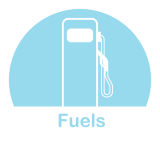Routes to Lower Greenhouse Gas Emissions Transportation Future
EPA's successful car and truck standards will lead to significant greenhouse gas (GHG) emissions reductions. Yet transportation still is, and will continue to be, a major contributor to carbon pollution, particularly as the population grows and more goods are shipped. The good news is that there are many opportunities to lower our climate impact.
- See regulations and standards for light-duty (cars)
- See regulations and standards for heavy-duty (trucks)
There are three routes to reducing GHGs from transportation: increasing the efficiency of vehicle technology, changing how we travel and transport goods, and using lower-carbon fuels. We need all three to help achieve our societal goals on climate.
Click on each symbol below to see some example strategies.
We can do this. America has a history of accomplishing large-scale changes in our transportation system. Between 1900 and 1920, cars overtook horses as the primary mode of personal transportation. The entire U.S. interstate highway system was built in just 35 years, and was transformational in its effects. Cargo, which was at one time always loaded and unloaded by hand in a wide range of shapes and sizes, is now frequently shipped in uniform containers that dramatically reduce shipping costs; this change was accomplished in 30 years. Broad application of today's proven technologies, fuels, and travel efficiency approaches can set us on a trajectory toward significant GHG reductions.
More opportunities await. History shows us that the future will likely hold even more advances and opportunities that we can't predict or even imagine. As these emerge, their adoption can allow reductions beyond those we can identify and assess today.
Interested in what's going to happen “down the road?” Check back soon to find new analyses and conversation starters about lowering GHG emissions from transportation.



